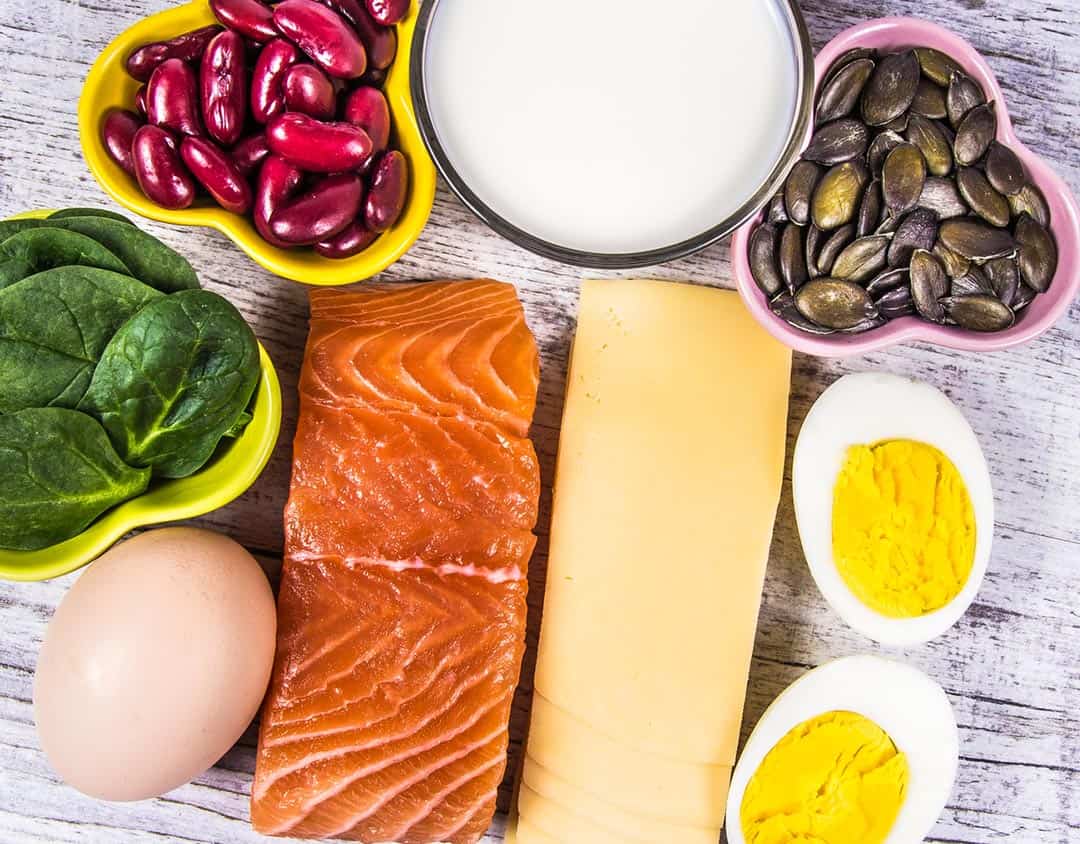
7 Ways to Healthfully Enjoy Holiday Eating
December 1, 2017
7 Nutrients of Concern on a Vegan Diet
September 5, 2019As many of you have seen with the updated Canada’s Food Guide released on January 22, 2019, there has been a shift in focus towards including more plants in our diet.
W hile this is great news for our planet and health, many of my clients are asking if they should be concerned about getting enough calcium now that the dairy and alternatives food group has been removed. The original Dairy and Alternatives and Meat and Alternatives food groups have been combined to form the new Protein-Rich Foods category. While grouping them together makes sense from a macronutrient perspective, not all protein rich foods are good sources of calcium. This means we may need to pay a little more attention to our plate to ensure we are including enough calcium rich foods on a daily basis.

It is very possible to get enough calcium while following the new food guide. We can do so by incorporating calcium rich foods into each of the new categories on the plate.
Let’s talk about bone health. The average person reaches their peak bone mass, the point where your bones reach their maximum density and strength, around the age of 30 years old. Not only is it important to get adequate calcium throughout childhood and adolescence to build strong bones, it is also important to ensure that we are getting adequate nutrition to preserve the health and mass of our bones throughout adulthood.
Calcium is a very important mineral that keeps your bones, teeth and muscles (including your heart) healthy and strong. Good calcium intake throughout your life can help to prevent osteopenia and osteoporosis. Osteoporosis is a disease that causes your bones to become brittle and break easily, which can lead to serious injuries.
How much calcium do I need every day?
| Age in Years | Aim for an intake of milligrams (mg)/day | Maximum you should take (mg)/day |
|---|---|---|
| Men and Women 19 to 50 | 1000 | 2500 |
| Women 51 to 70 | 1200 | 2000 |
| Men 51 to 70 | 1000 | 2000 |
| Men and Women 71 and older | 1200 | 2000 |
| Pregnant and Breastfeeding Women 19 and older | 1000 | 2500 |
What foods contain calcium?
You can meet your daily requirements by including 3-4 servings of dairy or fortified dairy alternative products per day. Each of the following servings provide approximately 300mg of calcium:
- 1 cup of cow’s milk
- 1 cup of fortified milk alternative (soy, almond, rice, cashew)
- ¾ cup of yogurt
- 1.5 oz of firm cheese
- 2 oz of soft cheese
- ½ cup of ricotta cheese
How can I get enough calcium without dairy/dairy alternative products? These foods provide approximately 150mg of calcium per serving:
- ¼ can of salmon with bones
- 1/3 cup of tofu, prepared with calcium sulfate
- ½ can of sardines with bones
- ½ cup of almonds or hazelnuts
- ½ cup of collard greens, cooked
- 1 cup of Bok choy or turnip greens, cooked
- 1.5 cups of kale, cooked
- 2.5 cups of broccoli, cooked
- 2 cups of pinto beans
- 1.5 cups of navy beans
- 1 tbsp of blackstrap molasses
- 10 dried figs
- ½ cup of calcium-fortified orange juice
For examples on how to incorporate these foods into a balanced plate, see the one-day Calcium Rich Meal Plan below.
Keep in mind that the bioavailability of calcium from foods varies greatly depending on the source. The bioavailability of calcium refers to the amount of calcium that is absorbed from our foods. The calcium found in dairy products and fortified dairy alternatives is generally much more bioavailable than the calcium found in other foods. For example, we absorb approximately 30% of the calcium found in cow's milk, but only about 5% of the calcium found in spinach. Therefore, it can be more challenging to reach your daily calcium requirements without consuming dairy or fortified dairy alternative products regularly.

If you’re unable to reach your daily calcium requirement through food alone, speak to your health care provider about adding a calcium supplement to your daily routine.


What about vitamin D?
Vitamin D aids with the absorption of calcium and phosphate from our foods. Adequate vitamin D therefore plays an important role in promoting bone health. Although there is not yet enough scientific evidence to conclusively recommend vitamin D for the prevention of other chronic diseases, vitamin D receptors are seen in various tissues around the body, such as the brain, muscle, and heart. This suggests that vitamin D may play an important role in the health of other areas in the body, but more research is needed.
How much vitamin D do I need per day?
| Age in Years | Aim for an intake of (IU – international units)/day | Stay below (IU)/day |
|---|---|---|
| Men and Women 19 to 50 | 600 | 4000 |
| Men and Women 51 to 70 | 600 | 4000 |
| Men and Women 71 and older | 800 | 4000 |
| Pregnant and Breastfeeding Women 19 and older | 600 | 4000 |
How do I get enough vitamin D every day?
Vitamin D, also known as the sunshine vitamin, can be formed in our skin when exposed to adequate sunlight or ultraviolet radiation. Multiple factors can decrease our ability to make enough vitamin D in our skin, for example wearing sunscreen, older age, not spending much time outdoors, having darker coloured skin, and living in northern countries, such as Canada. Therefore, getting our vitamin D from foods and supplements may be a more reliable source.
Unfortunately, vitamin D is not naturally found in many commonly eaten foods. Examples of vitamin D food sources:
- Salmon (75g): ~200-450 IU
- Mackerel, Pacific or canned (75g): ~200-300 IU
- Tuna or Halibut (75g): ~100-150 IU
- Egg yolks (2): 60-90 IU
- Vitamin D fortified egg yolks (2): ~150-250 IU
- Cow’s milk or fortified milk alternatives (250mL): 85-105 IU
- Fortified yogurt (175g): 80-120 IU
- Cod liver oil (5mL): 350-450 IU
As food sources are limited, experts recommend that all Canadians take a vitamin D supplement of 400-1000 IU per day. Adults 50 years old and older, at high risk for fractures or osteoporosis, should aim to have 800-2000 IU of vitamin D per day.
Vitamin D is a fat-soluble vitamin, meaning that your body can store extra amounts of vitamin D if taken in large amounts. Therefore, it is important to stay below the upper level of 4000 IU per day, from food and dietary supplements.
If you are wondering if you are getting enough calcium and vitamin D or are struggling to find sources to include in your diet, book a session with our Registered Dietitian here today!
Written by Liz Powell, RD and Celina So.
References:
- Bonjour, J., Theintz, G., Law, F., Slosman, D., & Rizzoli, R. (1994). Peak bone mass. Osteoporosis International, 4(S1)
- Food-nutrition.canada.ca. (2019). Canadian Nutrient File (CNF) [online] Available at: https://food-nutrition.canada.ca/cnf-fce/index-eng.jsp
- Health.gov. (2019). Appendix 12. Food Sources of Vitamin D - 2015-2020 Dietary Guidelines - health.gov. [online] Available at: https://health.gov/dietaryguidelines/2015/guidelines/appendix-12/
- Health.gov. (2019). Appendix 11. Food Sources of Calcium - 2015-2020 Dietary Guidelines - health.gov. [online] Available at: https://health.gov/dietaryguidelines/2015/guidelines/appendix-11/
- Ross, A. C. (2011). DRI, dietary reference intakes: Calcium, vitamin D. Washington, DC: National Academies Press.






